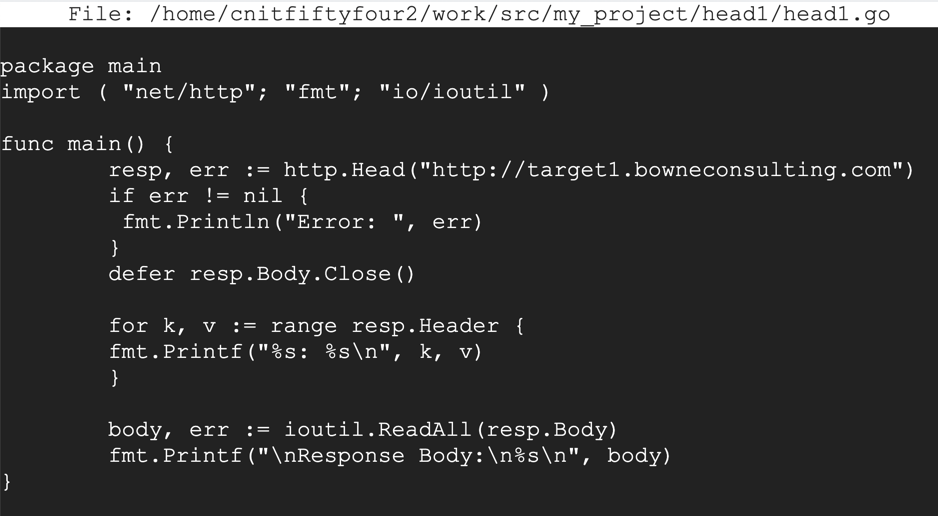
On your Linux server, in a Terminal window, execute these commands:
mkdir -p work/src/my_project/head1
nano ~/work/src/my_project/head1/head1.go
package main
import ( "net/http"; "fmt"; "io/ioutil" )
func main() {
resp, err := http.Head("http://target1.bowneconsulting.com")
if err != nil {
fmt.Println("Error: ", err)
}
defer resp.Body.Close()
for k, v := range resp.Header {
fmt.Printf("%s: %s\n", k, v)
}
body, err := ioutil.ReadAll(resp.Body)
fmt.Printf("\nResponse Body:\n%s\n", body)
}

Save the file with Ctrl+X, Y, Enter.
Execute these commands to compile the program and run it:
go install my_project/head1
head1
These are HTTP response headers, showing that my server is running Apache on Ubuntu.
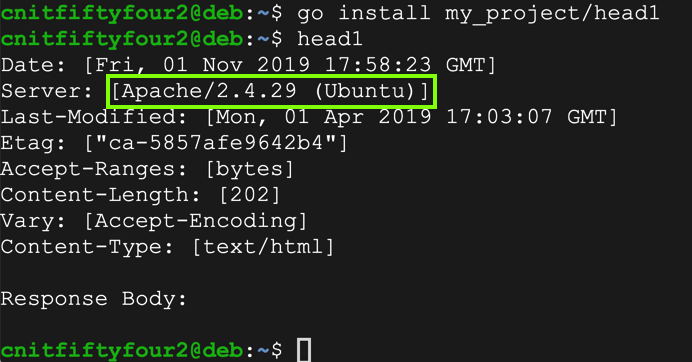
On your local computer, in a Web browser, go to:
The request your browser sent to the server appears, as shown below.
Notice the "User-Agent" header, which sends information about your browser to the server. I used Mozilla Firefox on a Mac--your User-Agent may be different.

On your Linux server, in a Terminal window, execute these commands:
mkdir -p work/src/my_project/get0
nano ~/work/src/my_project/get0/get0.go
package main
import ( "net/http"; "fmt"; "io/ioutil" )
func main() {
resp, err := http.Get("http://httpbin.org/get")
if err != nil {
fmt.Println("Error: ", err)
}
defer resp.Body.Close()
body, err := ioutil.ReadAll(resp.Body)
bodyString := string(body)
fmt.Printf("Response:\n%s\n", bodyString)
}
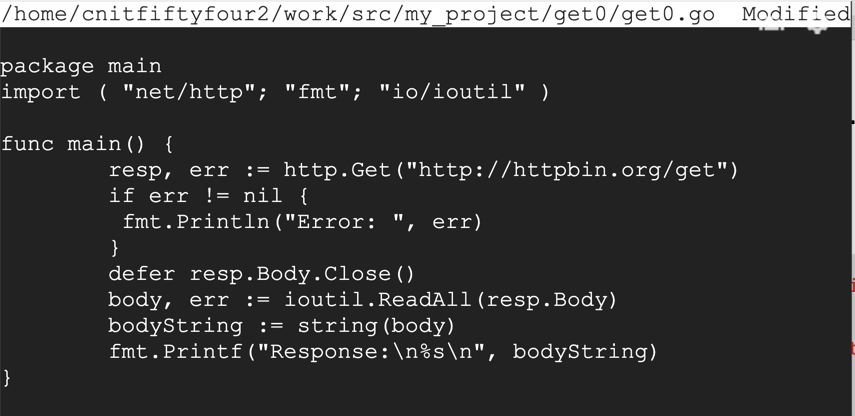
Save the file with Ctrl+X, Y, Enter.
Execute these commands to compile the program and run it:
go install my_project/get0
get0
It shows the request Go sent to the server, with a User-Agent of "Go-http-client/1.1".
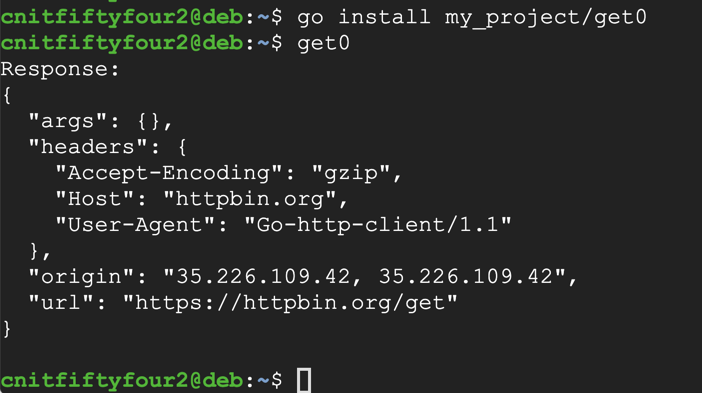
mkdir -p work/src/my_project/get1
nano ~/work/src/my_project/get1/get1.go
package main
import ( "net/http"; "fmt"; "io/ioutil" )
func main() {
resp, err := http.Get("http://target1.bowneconsulting.com")
if err != nil {
fmt.Println("Error: ", err)
}
defer resp.Body.Close()
body, err := ioutil.ReadAll(resp.Body)
bodyString := string(body)
fmt.Printf("Response:\n%s\n", bodyString)
}
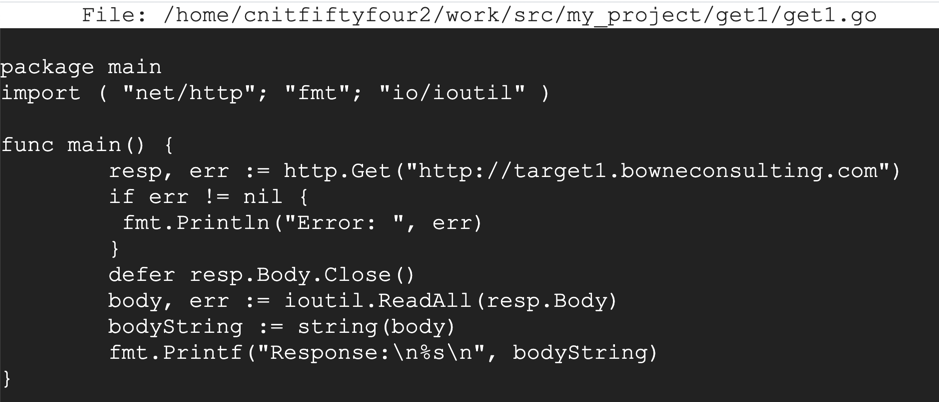
Save the file with Ctrl+X, Y, Enter.
Execute these commands to compile the program and run it:
go install my_project/get1
get1
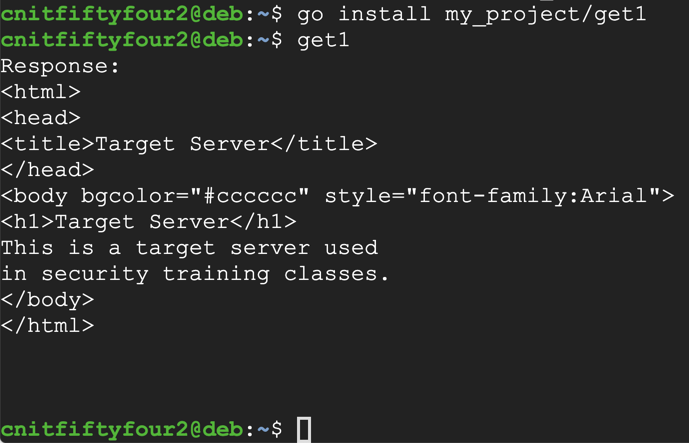
A new tab opens, showing the result. The username and password appear in the address bar, as shown below.
This is an unsafe but simple way to transmit credentials.
http://target1.bowneconsulting.com/php/login1.php?u=foo&p=bar
Let's make a Go script to perform this login.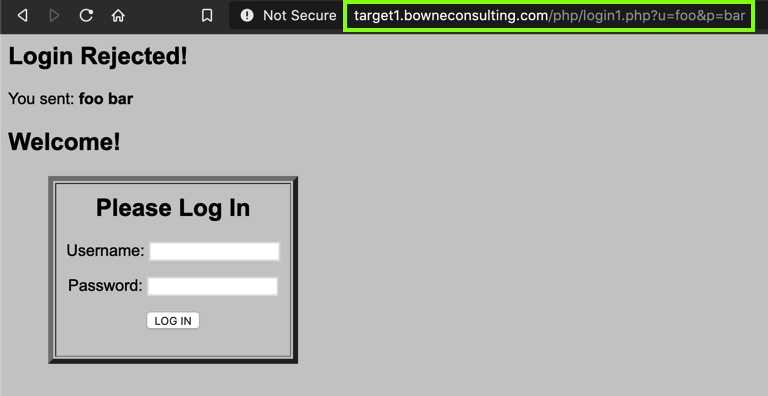
On your Linux server, in a Terminal window, execute these commands:
mkdir -p work/src/my_project/get2
nano ~/work/src/my_project/get2/get2.go
package main
import ( "net/http"; "fmt"; "io/ioutil" )
func main() {
resp, err := http.Get("http://target1.bowneconsulting.com/php/login1.php?u=foo&p=bar")
if err != nil {
fmt.Println("Error: ", err)
}
defer resp.Body.Close()
body, err := ioutil.ReadAll(resp.Body)
bodyString := string(body)
fmt.Printf("Response:\n%s\n", bodyString)
}
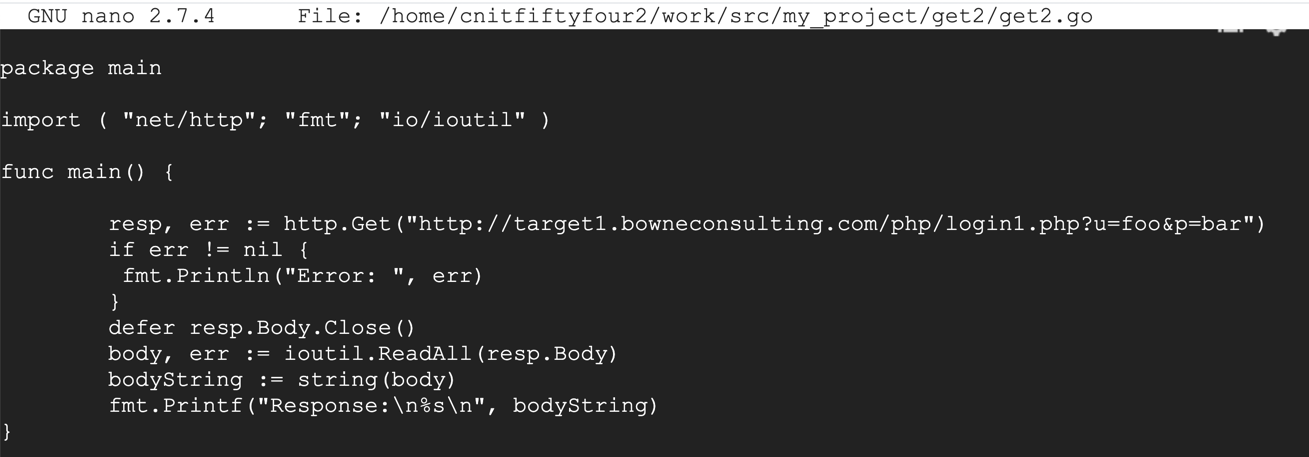
Save the file with Ctrl+X, Y, Enter.
Execute these commands to compile the program and run it:
go install my_project/get2
get2
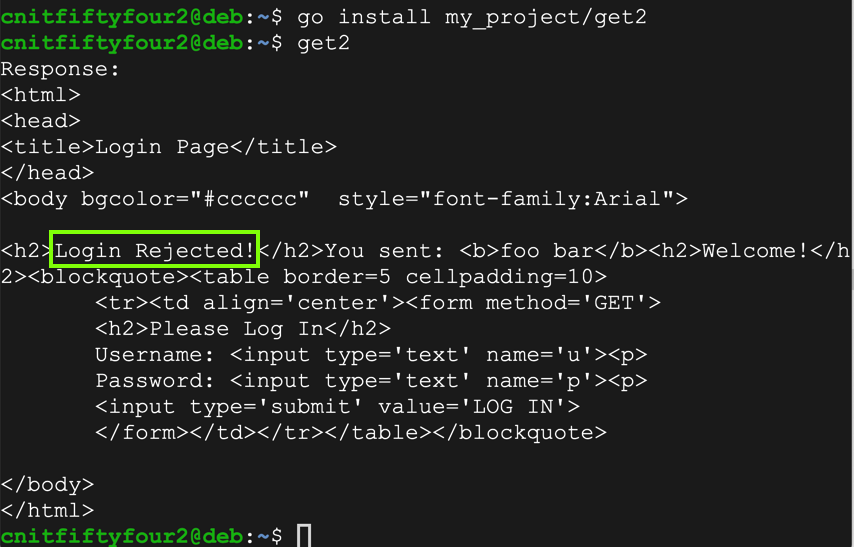
On your Linux server, in a Terminal window, execute these commands:
mkdir -p work/src/my_project/get3
nano ~/work/src/my_project/get3/get3.go
package main
import ( "net/http"; "fmt"; "io/ioutil" )
func main() {
username := "dumbo"
passwords := []string{"goofy", "mickey", "dumbo"}
url := "http://target1.bowneconsulting.com/php/login1.php?u="
for i, p := range passwords {
fmt.Printf("\nGuess %d: %s\n", i, p)
resp, err := http.Get(url + username + "&p=" + p)
if err != nil {
fmt.Println("Error: ", err)
}
defer resp.Body.Close()
body, err := ioutil.ReadAll(resp.Body)
bodyString := string(body)
fmt.Printf("Response:\n%s\n", bodyString)
}
}
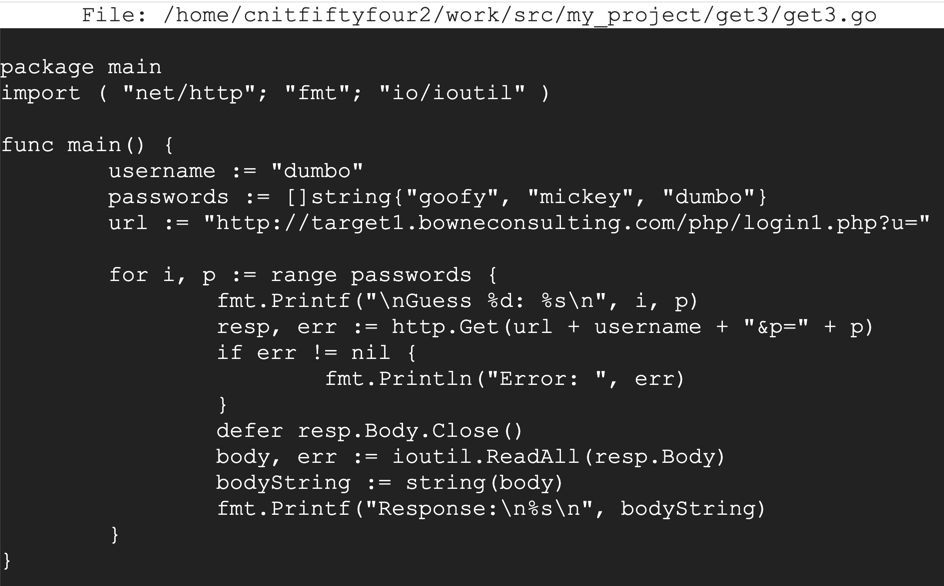
Save the file with Ctrl+X, Y, Enter.
Execute these commands to compile the program and run it:
go install my_project/get3
get3

Log in with a username of foo and a password of bar in the form below:
A new tab opens, showing the result.
Notice at the URL no longer includes the username or password. They are transmitted in a separate "form" section, as shown below.
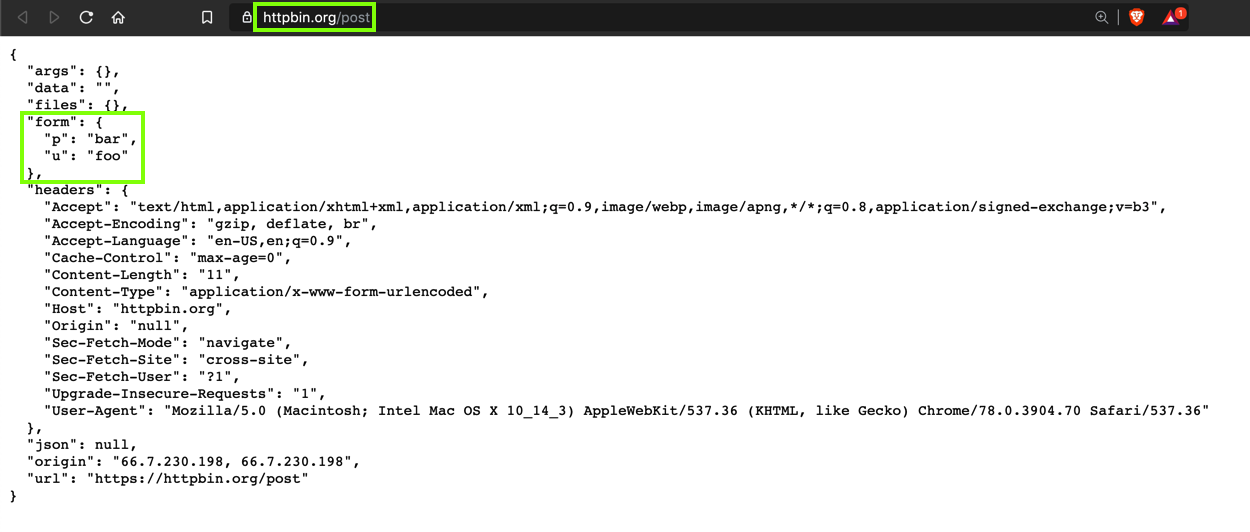
mkdir -p work/src/my_project/post1
nano ~/work/src/my_project/post1/post1.go
package main
import ( "net/http"; "fmt"; "io/ioutil"; "net/url")
func main() {
target := "http://httpbin.org/post"
resp, err := http.PostForm( target, url.Values{ "u": {"foo"}, "p": {"bar"} } )
if err != nil {
fmt.Println("Error: ", err)
}
defer resp.Body.Close()
body, err := ioutil.ReadAll(resp.Body)
bodyString := string(body)
fmt.Printf("Response:\n%s\n", bodyString)
}
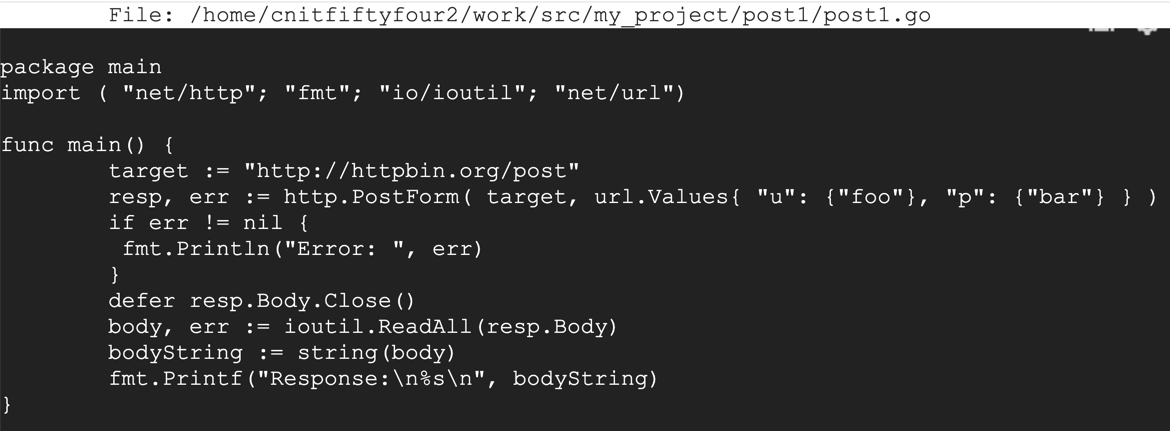
Save the file with Ctrl+X, Y, Enter.
Execute these commands to compile the program and run it:
go install my_project/post1
post1
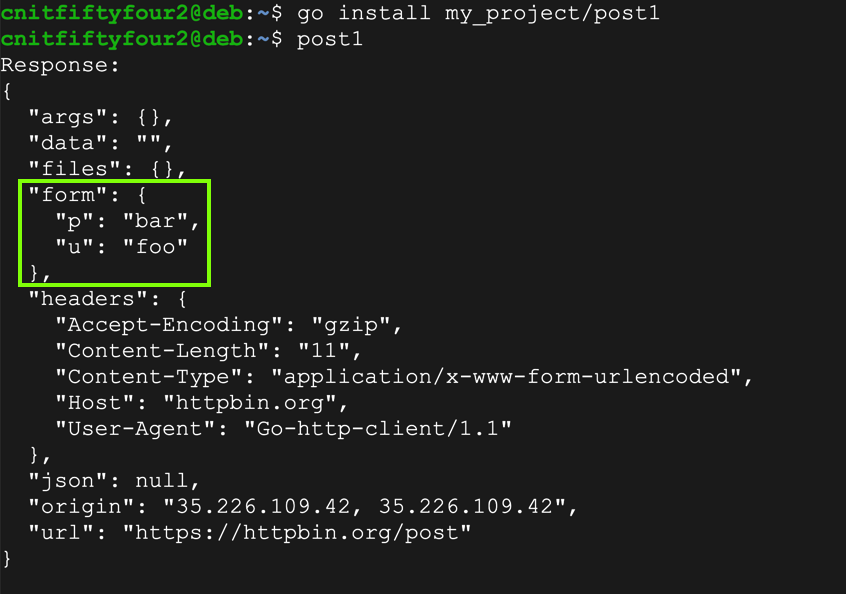
A new tab opens, showing the result. Notice that the URL ends in login2.php, as shown below.
On your Linux server, in a Terminal window, execute these commands:
mkdir -p work/src/my_project/post2
nano ~/work/src/my_project/post2/post2.go
package main
import ( "net/http"; "fmt"; "io/ioutil"; "net/url" )
func main() {
username := "dumbo"
passwords := []string{"goofy", "mickey", "dumbo"}
target := "http://target1.bowneconsulting.com/php/login2.php?u="
for i, p := range passwords {
fmt.Printf("\nGuess %d: %s\n", i, p)
resp, err := http.PostForm( target, url.Values{ "u": {username}, "p": {p} } )
if err != nil {
fmt.Println("Error: ", err)
}
defer resp.Body.Close()
body, err := ioutil.ReadAll(resp.Body)
bodyString := string(body)
fmt.Printf("Response:\n%s\n", bodyString)
}
}
Execute these commands to compile the program and run it:
go install my_project/post2
post2

http://target1.bowneconsulting.com/php/login3.php
with these parameters:
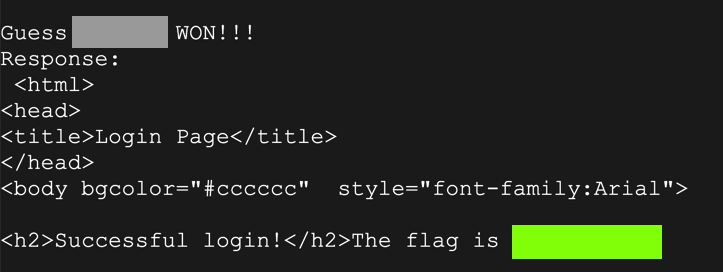
Hints:
http://target1.bowneconsulting.com/protected/A2.3/index.php
It's protected by Basic authenticatin, with a username of admin and a password of P@ssw0rd
The server will reply with a flag.
http://target1.bowneconsulting.com/protected/A2.4
with these parameters:
Posted: 11-3-19
Challenge numbers fixed 2-22-2020